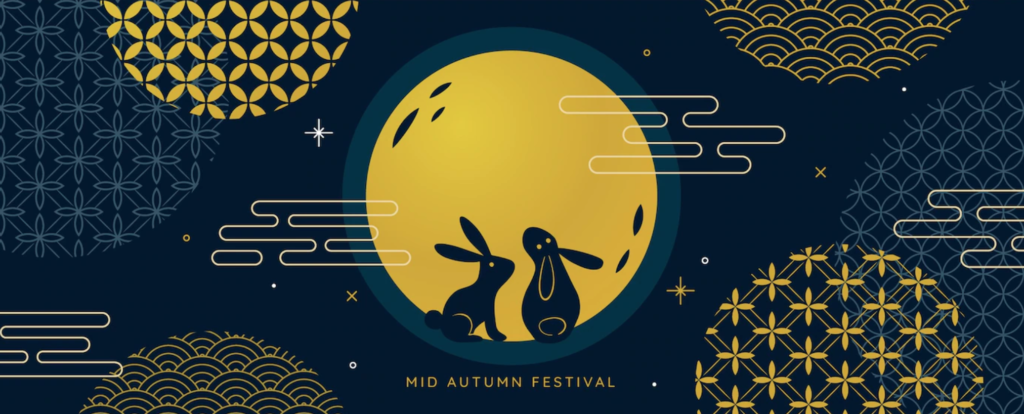Moon Cakes and the Mid-Autumn Festival
Happy Mid-Autumn Festival from Sun Food Trading! This year’s festival falls on September 10th. This is when the moon is at it’s biggest and brightest. We suggest you cut each mooncake into fourths and share with everybody.

Fable
Houyi was himself an immortal, while Chang’e was a beautiful young girl, working in the Jade Emperor‘s (Emperor of Heaven) Palace as the attendant to the Queen Mother of the West (wife of the Jade Emperor), before her marriage. One day, Houyi aroused the jealousy of the other immortals, who then slandered him before the Jade Emperor. Houyi and his wife, Chang’e, were subsequently banished from heaven, and forced to live by hunting on earth. He became a famous archer.
Now at this time, there were 10 suns that took turns to circle the earth — one every 10 days. One day, all 10 of the suns circled together, causing the earth to scorch. Emperor Yao, the Emperor of China, commanded Houyi to kill all but one of the suns. Upon the completion of his task, the Emperor rewarded Houyi with a pill, the elixir of life, and advised him: “Make no haste to swallow this pill, but first prepare yourself with prayer and fasting for a year”. Houyi took the pill home and hid it under a rafter, while he began healing his spirit. In the midst of this, Houyi was summoned again by the emperor. While he was gone, Chang’e noticed a white beam of light beckoning from the rafter and discovered the pill, which she swallowed. Immediately, she found that she could fly. Just at that moment, Houyi returned home, and realizing what had happened, began to reprimand her. Chang’e flew out the window into the sky.
With bow in hand, Houyi sped after her, and the pursuit continued halfway across the heavens. Finally, Houyi had to return to the Earth because of the force of the wind. Chang’e reached the moon, and breathless, she coughed. Part of the pill fell out from her mouth. Now, the hare (Many cultures see a hare in the pattern of dark patches in the moon) was already on the moon, and Chang’e commanded the animal to make a pill from it, so that she could return to earth to her husband.
As of today, the hare is still pounding. As for Houyi, he built himself a palace in the sun as “Yang” (the male principle), while Chang’e is “Yin” (the female principle). Once a year, on the 15th day of the full moon, Houyi visits his wife. That is why the moon is full and beautiful on that night.
Origin
The Mid-Autumn Festival is a traditional festivity for both the Han and minority nationalities. The custom of worshipping the moon (called xi yue in Chinese) can be traced back as far as the ancient Xia and Shang Dynasties (2000 B.C.-1066 B.C.). In the Zhou Dynasty (1066 B.C.-221 B.C.), people hold ceremonies to greet winter and worship the moon whenever the Mid-Autumn Festival sets in. It becomes very prevalent in the Tang Dynasty (618-907 A.D.) that people enjoy and worship the full moon. In the Southern Song Dynasty (1127-1279 A.D.), however, people send round moon cakes to their relatives as gifts in expression of their best wishes of family reunion. When it becomes dark, they look up at the full silver moon or go sightseeing on lakes to celebrate the festival. Since the Ming (1368-1644 A.D.) and Qing Dynasties (1644-1911A.D.), the custom of Mid-Autumn Festival celebration becomes unprecedented popular. Together with the celebration there appear some special customs in different parts of the country, such as burning incense, planting Mid-Autumn trees, lighting lanterns on towers and fire dragon dances. However, the custom of playing under the moon is not so popular as it used to be nowadays, but it is not less popular to enjoy the bright silver moon. Whenever the festival sets in, people will look up at the full silver moon, drinking wine to celebrate their happy life or thinking of their relatives and friends far from home, and extending all of their best wishes to them.
Mooncakes
There is this story about the moon-cake. During the Yuan dynasty (A.D. 1280-1368) China was ruled by the Mongolian people. Leaders from the preceding Sung dynasty (A.D. 960-1280) were unhappy at submitting to the foreign rule, and set how to coordinate the rebellion without being discovered. The leaders of the rebellion, knowing that the Moon Festival was drawing near, ordered the making of special cakes. Backed into each moon caked was a message with the outline of the attack. On the night of the Moon Festival, the rebels successfully attached and overthrew the government. Today, moon cakes are eaten to commemorate this legend.
For generations, moon cakes have been made with sweet fillings of nuts, mashed red beans, lotus-seed paste or Chinese dates, wrapped in a pastry. Sometimes a cooked egg yolk can be found in the middle of the rich tasting dessert. People compare moon cakes to the plum pudding and fruit cakes which are served in the English holiday seasons.
Nowadays, there are hundreds varieties of moon cakes on sale a month before the arrival of Moon Festival.
(All information reproduced from Chinavoc.com and Wikipedia.com)

Recent Comments